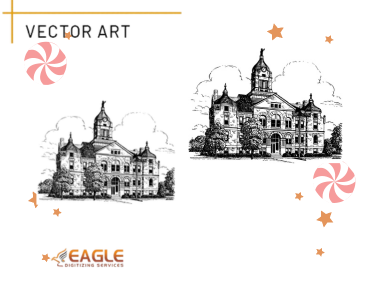What is an Embroidery Digitizer? A Beginner's Guide
Have you ever marveled at a beautifully embroidered design and thought, “How did they get that intricate pattern onto the fabric so flawlessly?” Although it's simple to assume that all you need is a needle and a steady hand, there is a little more to the procedure. Enter the embroidery digitizer – the unsung hero behind the scenes!
If you’re new to the embroidery world or simply curious about the process, you’re in the right place. In this blog, we’ll demystify the role of an embroidery digitizer, explaining how they turn artwork into stitchable designs and why their work is crucial for achieving those stunning results.
We'll start by exploring what exactly an embroidery digitizer does. Essentially, this professional uses specialized software to convert digital images or designs into a format that an embroidery machine can understand. This involves a combination of creativity and technical skill – from selecting the right thread colors to determining the stitch types and density to ensure the design looks perfect when stitched out.
Next, we’ll dive into the technical side of things. You'll learn about the different types of embroidery software and the process of creating a digitized design. We’ll break down how the software interprets the design and translates it into a series of commands that guide the embroidery machine, ensuring each stitch is placed precisely.
Finally, we'll discuss why embroidery digitizing is so essential. A well-digitized design can make the difference between professional-looking embroidery and a disappointing result. Proper digitizing ensures that designs are not only aesthetically pleasing but also durable and suitable for the chosen fabric.
Ready to uncover the magic behind those intricate embroidery designs? Let’s get started!
What Exactly is an Embroidery Digitizer?
In the simplest terms, an embroidery digitizer is a tool or software that transforms artwork—whether it’s a logo, design, or image—into a format that an embroidery machine can understand and use. Embroidery machines can’t work with regular image files like JPGs or PNGs. Instead, they need specific types of files that provide detailed instructions on how to stitch the design. That’s where the digitizer comes in—it translates your design into a step-by-step guide for the machine, telling it exactly how to create the artwork stitch by stitch.
However, it's not just about the software. There’s also the person using the software—known as the embroidery digitizer—who plays a crucial role in preparing the design. This skilled individual uses the software to make sure the design is optimized for embroidery, adjusting elements like stitch direction and density to ensure everything looks perfect on the fabric. So when you hear the term “embroidery digitizer,” it could be referring to both the software itself and the talented professional who operates it.
How Does Embroidery Digitizing Work?
Think of embroidery digitizing as translating artwork into a language that embroidery machines can understand. Here's a detailed explanation of how everything works together:
1. Start with an Image: It all begins with the artwork, which could be anything from a simple letter to a complex and colorful illustration. This is the design you want to turn into embroidery.
2. Load the Image into the Software: Next, the image is imported into embroidery digitizing software. This isn’t a simple drag-and-drop process; it requires a skilled digitizer to interpret and convert the image into a format that the machine can work with. The digitizer adjusts various settings to ensure the final design will look just right on the fabric.
3. Plot the Stitches: The digitizer then decides how the design will be stitched. This involves selecting the types of stitches (like satin or fill stitches), determining their direction, and planning out the level of detail. Different stitch types and directions can give the design various textures and finishes, so this step is crucial for achieving the desired look.
4. Set Stitch Density: Stitch density refers to how close or far apart the stitches are placed. If the stitches are too loose, the design might appear sparse or incomplete. If they’re too tight, it can cause the fabric to bunch up or become stiff. Finding the right balance is key to a smooth, professional-looking finish.
5. Save in Machine-Readable Format: Once the design is perfected, it’s saved in a format that the embroidery machine can read, such as .DST or .PES. The specific format depends on the type of machine being used.
6. Embroidery Machine: Finally, the digitized file is loaded into the embroidery machine. With everything set up, the machine begins stitching the design onto the fabric, bringing your artwork to life!
So, embroidery digitizing involves a combination of art, technology, and a bit of technical know-how to ensure your design turns out beautifully on any piece of fabric.
Why is an Embroidery Digitizer Crucial?
An embroidery digitizer plays a pivotal role in transforming stunning designs on caps, jackets, and bags into reality. It acts as the essential link between artistic vision and practical embroidery execution. Here’s why having a skilled embroidery digitizer is indispensable:
1. Precision and Accuracy: The digitizer meticulously converts designs into a format that ensures every stitch is perfectly placed. This attention to detail results in flawless embroidery that matches the original artwork exactly.
2. Custom Designs: With an embroidery digitizer, you’re not confined to off-the-shelf patterns. Instead, you can design bespoke artwork and have it transformed into one-of-a-kind embroidered creations, tailored to your specific needs.
3. Time Efficiency: Although digitizing a design initially requires some setup time, it significantly speeds up the production process. Once digitized, the design can be replicated swiftly and accurately by the embroidery machine, making it ideal for large orders.
4. Consistency: The digitizer ensures that every iteration of the design is uniform. This consistency is crucial for businesses that require multiple identical items, guaranteeing that each piece looks as perfect as the last.
In summary, an embroidery digitizer is essential for achieving high-quality, custom embroidery with precision, efficiency, and consistency.
Types of Stitches in Embroidery Digitizing
When it comes to embroidery digitizing, understanding the various types of stitches is crucial. Each stitch type contributes a unique texture and appearance to the final design. Here are some common stitches and their uses:
1. Satin Stitch:
○ Description: Satin stitches are used primarily for creating smooth, shiny outlines or letters. They are made by stitching parallel lines very close together, which creates a dense, reflective surface.
○ Visual Effect: This stitch gives a sleek, polished look and is great for details that need to stand out, such as text or borders. Its smooth finish adds a touch of elegance to the design.
2. Fill Stitch:
○ Description: Fill stitches are used to cover larger areas with thread. They fill in spaces to create a solid, uniform look. This stitch can be done in various patterns, such as straight or zigzag lines, depending on the desired texture.
○ Visual Effect: Ideal for background sections or large blocks of color, fill stitches provide a consistent, solid appearance. They are perfect for areas that need to be filled in completely without gaps.
3. Running Stitch:
○ Description: Running stitches are simple, single-line stitches used for delicate details or outlining designs. They are often used to create fine lines or to add texture with minimal bulk.
○ Visual Effect: This stitch is versatile and subtle, making it ideal for creating fine lines, adding detail, or outlining smaller elements of a design. It provides a lighter, more delicate finish compared to satin or fill stitches.
4. Backstitch:
○ Description: The backstitch is a strong, continuous stitch used for outlining or creating solid lines. It involves stitching backward over the previous stitch, creating a sturdy and defined line.
○ Visual Effect: This stitch is great for adding structure and definition to designs, making it suitable for outlining intricate patterns or reinforcing edges.
5. Chain Stitch:
○ Description: Chain stitches create a series of looped stitches that resemble a chain. They are often used for decorative purposes or to add texture to designs.
○ Visual Effect: This stitch adds a textured, decorative element to the design. It can be used for borders, accents, or to enhance specific parts of the embroidery with a unique look.
6. Fill Stitch Variations:
○ Description: Besides the basic fill stitch, there are variations like contour fills and gradient fills. Contour fills follow the outline of a shape, while gradient fills transition from one color or shade to another.
○ Visual Effect: Contour fills add depth and dimension by following the design’s shape, while gradient fills create a smooth transition of color, adding a more dynamic and visually interesting effect.
Each type of stitch has its role in embroidery digitizing, contributing to the overall texture, appearance, and quality of the final embroidered product. Understanding these stitches helps ensure that the design not only looks great but also functions well on various fabrics and applications.
DIY vs. Hiring a Pro Digitizer
Thinking about digitizing your designs yourself? It’s doable, but it might take a bit of practice. There are some great beginner-friendly embroidery digitizing software options out there. Just keep in mind that getting the hang of it can take time. You’ll need to learn how to work with different fabrics, manage stitch direction, and adjust stitch density, which can be a bit tricky.
On the other hand, bringing in a professional digitizer can be a real game-changer. They’ll save you time and make sure your design comes out looking sharp and high-quality. Pros know the ins and outs of making designs look great on all sorts of fabrics, handling complex patterns, and fixing any issues that pop up during stitching. If you want a smooth and polished result without the learning curve, hiring a pro might be the way to go!
Conclusion: Bringing Designs to Life with Embroidery Digitizing
In a nutshell, an embroidery digitizer is both the software and the skilled individual responsible for transforming artwork into stitch-ready files that embroidery machines can understand. It’s the invisible yet critical step that bridges the gap between design and the finished embroidered product. Whether you're a passionate hobbyist looking to personalize your items or a business owner who wants to add unique embroidery to your products, understanding what an embroidery digitizer does is key to achieving professional, high-quality results.
The process of digitizing goes far beyond simply uploading an image into a machine. It involves careful planning, precision, and a deep knowledge of embroidery techniques. The digitizer must consider factors like fabric type, stitch length, and density, ensuring the final product is smooth, detailed, and vibrant. With the right combination of skills and tools, even the most intricate design can be faithfully recreated on fabric.
Now that you know the basics, the next time you admire an intricate embroidered design on a shirt, jacket, or hat, you'll have a deeper appreciation for the digital craftsmanship behind it. Behind every stitch is thoughtful planning and the work of an embroidery digitizer who made it all possible. Whether you choose to digitize your designs or hire a professional, you’ll have the foundation to bring your creative visions to life – one stitch at a time!



.png)